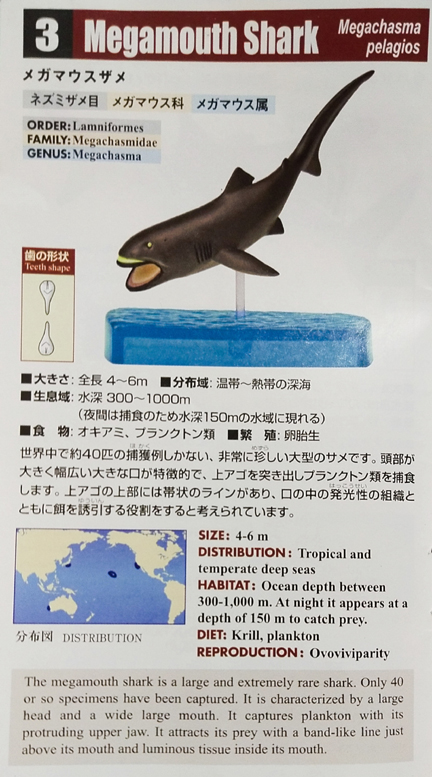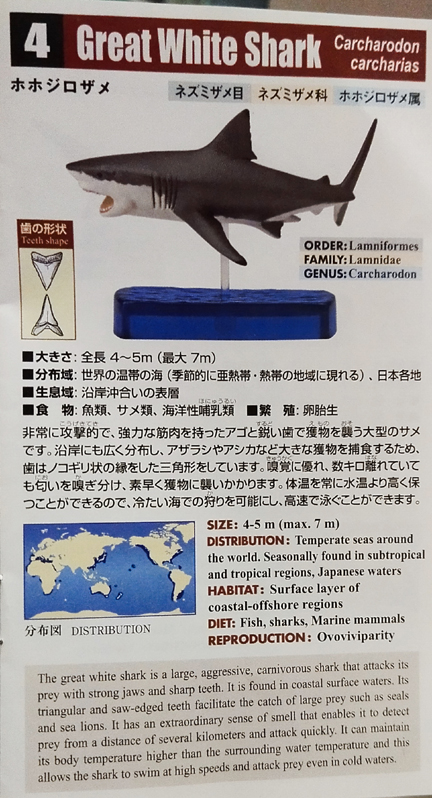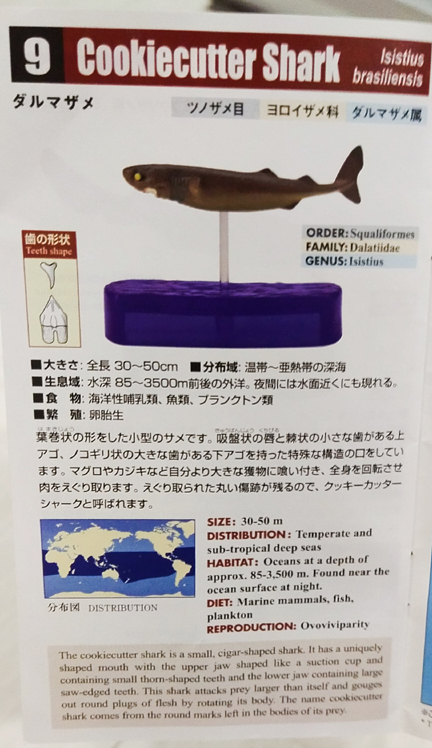Review and images by JimoAi; edited by bmathison1972
Sharks are master hunters. They have inhabited the world’s oceans since the Silurian period and are still standing strong today, even though their population is dwindling due to human greed. They have a basic body plan of a streamlined body, having cartilage rather than bone for their skeletal structure, external gill slits on either sides of the head, and pectoral fins that are not fused to the head. Despite the general public’s view on sharks as blood thirsty killing machines, in reality, sharks are intelligent beings and only a handful species out of the 500 known today are dangerous to humans. Sharks are primarily carnivores and primarily prey on fish, crustaceans, mollusks, and the larger species are known to take sea birds, pinnipeds, marine reptiles, and cetaceans.

Sharks have evolved various ways of feeding as seen in this set Colorata released in 2010, which has 9 sharks grouped in 3 categories: filter feeders, large predators, and unusual deep sea sharks. The sharks will be reviewed according to the number they are given on the booklet that comes with the set, which all Colorata sets include. I will also add that most Colorata sets comes with translucent rods that attach the animal figure onto their bases; I for myself am neutral about bases. I’m all for bases if it depicts an animal’s habitat while I would rather go without a base if the base is plain and mundane. With that out of the way, let’s dive in to the 9 sharks that were produced for this box set. And since more than half of the sharks in this set have claspers, I will be adding a gender point.
Whale shark (Rhincodon typus)
- Size of figure: 15.7 cm
- Size of actual animal: males mature at about 800 cm to 900 cm, full size for males currently unknown
- Scale: about 1:51 to 1:57 for a sexually mature male, possibly larger
- Color: blue dorsal region with white underbelly, bluish stripes and off white stripes, pale pink mouth interior
- Diet: small fish and squid, krill, plankton
- Species frequency of being made: common
- Sex: male
Notes: The largest figure in the set is most fittingly the largest species in the world. This whale shark is currently the only whale shark figure I know to be sculpted with claspers and this is Colorata’s forth whale shark figure, along with the older Sharks of the World set, retired Ocean Kingdom, Okinawa Collab, and Deluxe Museum models. This and 4 others (the great white, basking, bull, and tiger) are textured as if to give off the impression of denticles. All whale shark figures sculpted by major companies seem at least passable with the key whale shark features of a flattened head with lines and spots as patterns. This is my favourite figure in the set for the sole reason that the whale shark is my favourite shark species.



Basking shark (Cetorhinus maximus)
- Size of figure: 12 cm
- Size of actual animal: 680 cm to 1000 cm for an adult
- Scale: About 1:56.66 to 1:83.333
- Color: greyish dorsal region with white underbelly patch, pale mouth and red slightly opened gill slits
- Diet: small fish, zooplankton
- Species frequency of being made: very rare
- Sex: female
Notes: This figure is seriously under-sized as despite being the second largest fish and shark alive today, it is only the third largest figure, behind the great white shark, which makes this basking shark looks like a juvenile or a baby compared to a male great white shark. This basking shark was the only 2 basking shark figures in existence at that time, alongside the Safari Ltd figure, but in 2021, CollectA is releasing another figure of the species.



Megamouth Shark (Megachasma pelagios)
- Size of figure: 11.5 cm
- Size of actual animal: at least 540 cm
- Scale: at least 1:46 scale
- Color: dark brown dorsal region with lighter brown underbelly, pinkish mouth, yellow eye with black pupil and a yellow gum region
- Diet: Small fish, zooplankton, krill, jellyfish
- Species frequency of being made: rare
- Sex: female
Notes: This was the third figure of a megamouth shark produced, as prior to it Kaiyodo and Takara Tomy A.R.T.S. had made one, and Safari Ltd. made one after this figure was released. Interestingly, the booklet shows a megamouth shark with a yellow eye with no pupils while pupils are present in the final product. Megamouth sharks are rare on the market, so this is a welcome addition!



Great White Shark (Carcharodon carcharias)
- Size of figure: 13 cm
- Size of actual animal: about 330 cm to 400 cm for a male, although ‘Apache’ a male, was 537 cm, still smaller than the largest female, Deep Blue, estimated to be 600 cm
- Scale: About 1:26 to 1:31 scale for an average male but 1:41 for Apache’s size
- Color: Dark grey with white underbelly, black tips on pectoral fins and pinkish mouth interior and gums
- Diet: Bony fishes, other cartilaginous fishes, cetaceans, pinnipeds, sea birds, and maybe cephalopods, sea turtles, and scavengers on carcasses and maybe cannibalism
- Species frequency of being made: common
- Sex: Male
Notes: The most popular shark needs no introduction. This shark has countless figures and Colorata has 4 other versions for their Ocean Kingdom, original Sharks of the World, Sharks of the World Museum Model, and a larger model that looks like it came as a model kit. As with the other 3 large predatory sharks, this one has claspers sculpted on it. This great white is sculpted with his mouth open but there is only 1 role of teeth present on the top and bottom jaw. Not the worst great white, but it’s probably the weakest in the set in terms of aesthetics.



Bull Shark (Carcharhinus leucas)
- Size of figure: 10.5 cm
- Size of actual animal: Males get to 220 cm
- Scale: 1:21
- Color: greyish dorsal region with white underbelly, white eye with black slut pupil, black tips on fins
- Diet: Bony fish, other cartilaginous fish, turtles, cetaceans, maybe some land mammals, sea birds; also engaged in cannibalism
- Species frequency of being made: rare
- Sex: male
Notes: Known as the most dangerous shark due to its ability to tolerate freshwater and its tendency to inhabit waters that often is humans frequent. As of this figure’s release date, Safari Ltd. had a figure of this species, and also an atrocious one by K&M International. In 2019, Papo released theirs. The side profile of figure is alright but when view from stop, my biggest complaint arises. It does not look too much like a bull shark due to its nose being more pointed, more akin to a blacktip shark (Carcharhinus limbatus) and some other requiem sharks rather than a bull shark. In short, this figure makes a better blacktip shark rather than a bull shark.



Tiger Shark (Galeocerdo cuvier)
- Size of figure: 11.5 cm
- Size of actual animal: 400 cm for the largest male
- Scale: about 1: 35 scale
- Color: dark grey dorsal region with dark grey stripes, lighter grey mid region and white underbelly, pinkish mouth with darker pink gums, and black tips on caudal and dorsal fin.
- Diet: Widest food spectrum of all sharks, including bony and cartilaginous fish, cetaceans, pinnipeds, marine reptiles, cephalopods, jellyfish, sea birds and even inanimate objects like tin cans and license plates.
- Species frequency of being made: uncommon
- Sex: Male
Notes: Unlike the bull shark, Colorata got the snout shape correct for this tiger shark. This is the only tiger shark that is sculpted with claspers before the introduction of the 2016 Schleich version. Other good figures of this species includes both the Monterey Bay Aquarium and Wild Safari Sea life figures by Safari Ltd., Schleich, and the CollectA one, which lacks the 5th gill slit. Colorata also made one for their original Sharks of the World set.



Frilled Shark (Chlamydoselachus anguineus)
- Size of figure: 9 cm when stretched out
- Size of actual animal: at least 170 cm for a male
- Scale: at least 1:19
- Color: chocolate brown body with a paler brown underbelly, black eye with green pupil and bluish highlight on fin tips
- Diet: Fish and cephalopods
- Species frequency of being made: Rare
- Sex: male
Notes: The only shark with 6 gills in the set and the only male frilled shark figure in existence so far! Safari Ltd. has one for their retired Prehistoric Sea life TOOB as with Kaiyodo, Ikimon/Nature Techni Colour, Epoch, and Takara Tomy. Perhaps the most common deep sea shark figure made and it’s pretty easy to see why. It looks more like an eel than a typical shark in body plan.



Goblin Shark (Mitsukurina owstoni)
- Size of figure: 10.8 cm
- Size of actual animal: ranges from 300 to 400 cm, but a female caught in 2000 could be up to 600cm!
- Scale: 1:28 to 1:37, maybe up to 1:57
- Color: a creamy body, white eyes with black pupil and pinkish mouth
- Diet: bony fish, smaller cartilaginous fish, squid, and crustaceans
- Species frequency of being made: very rare
- Sex: female
Notes: like most goblin shark figures, this figure is sculpted incorrectly with the lower jaw protruding out, which will only happen during feeding. This species has only been made a handful of times by Play Visions, Kaiyodo ,and Takara Tomy A.R.T.S., all which are pretty small, with this Colorata one being the largest. We really need companies like Safari Ltd. and CollectA to make a larger goblin shark!



Cookiecutter Shark (Isistius brasiliensis)
- Size of figure: 6.3 cm
- Size of actual animal: 50 cm
- Scale: 1:7.5
- Color: Dark brown dorsal region with chocolate brown mid and lower body, bluish gills and black eye with yellow pupil
- Diet: Takes cookie-shape bites out of larger fish and marine mammals
- Species frequency of being made: Very rare
- Sex: female
Notes: The smallest figure in the set and the only species in the dogfish family ever made. The only other cookiecutter I’m familiar with is the one by Takara Tomy A.R.T.S., and that one is much smaller. Interestingly, these sharks were responsible for taking chunks out of submarines during the cold war and are bioluminescent to attract potential prey, after which the sharks will take a chunk out of it.



Overall, this set carries a great assortment of shark figures on the collecting market with both well-known and obscure species. Like most Colorata sets, this set is still in production, although getting them outside of Japan is proven to be pricey. For me, I prefer mixing the figures with this set and the older Sharks of the World set as that set contains both days and sharks while this set contains only sharks; however, this set has the upper edge when it comes to quality and the inclusion of deep-sea shark species. Highly recommend for any shark fans willing to pay a high price for obscure species and high quality figures.
Disclaimer: links to Ebay and Amazon on the AnimalToyBlog are affiliate links, so we make a small commission if you use them. Thanks for supporting us!




Great evaluation of this set. I agree that the weakest figure is the white shark, my personal favorite is the cookie cutter out of this bunch.
I do wish the term “sex” was used in place of “gender”. Sharks don’t have genders, they have sexes. Gender is a human sociological construct, not biological.
Got it. Will take note for future reviews
thanks. I knew that and should have caught that in the editing; I’ll pay closer attention in the future. For now, I have edited this post accordingly.
I have the goblin shark from this set. I would like the cookiecutter, but am content with the Takara version. There is a third cookiecutter shark, by Neko Works, but it comes unpainted.
A real interesting set and nice photos, thanks for reviewing.
I just find the knobby skin on some of them a very weird choice. I am aware sharks have “teeth” on their skin surface to lower drag in the water, but from a distance you can`t see those tiny structures and the addition of stome wrinkles (as the real deal basking shark) sensory holes or scars (on the great white) would have been the better way to go.